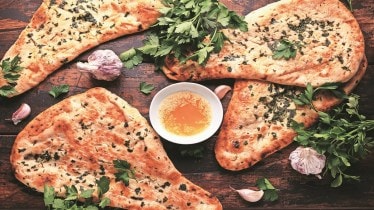Imagine a highway dhaba. A lively atmosphere with casual seating, often cots even, sound of bustling conversations, peppy music and heady food aromas, especially dal makhani simmering in huge cauldrons, and a tandoor spitting out tempting offerings.
Most people will agree that a perfect dhaba meal of paneer tikka, dal makhani and butter chicken is incomplete without a naan with dollops of ghee and butter. However, the leavened, oven-baked or tawa-fried flatbread, often cooked in a tandoor, and a popular accompaniment to Indian dishes, has gone beyond highway dhabas to be the world’s number one flatbread in popularity.
TasteAtlas, a renowned online food guide known for showcasing global cuisines and dishes, in its 2025 ranking of the world’s 50 best breads, has listed butter garlic naan on the top spot with a 4.7 rating by the guide. The official website of TasteAtlas described the bread as — “Butter garlic naan is a traditional flatbread and one of the most popular versions of naan. It’s made with flour, baking powder, salt, sugar, and dahi. Once the dough has been baked in a hot tandoor oven, the golden naan is taken out and brushed with butter or ghee, then topped with minced garlic.”
Not just butter garlic naan but a total of eight Indian breads secured a spot on the list. Amritsari kulcha bagged the second spot, while the South Indian parotta grabbed the sixth spot. The other breads on the list are — naan on the eighth spot, paratha on the 18th spot, bhatura on 26th position. There’s also aloo naan, which snagged the 28th spot, and the roti on the 35th position.
Other breads like Pao De Queijo at number 10 is a popular Brazilian cheese bread that features a crisp outer layer and a soft, chewy interior. At number 9 is Piadina Romagnola, a traditional Italian flatbread from the Emilia-Romagna region, known for its thin, soft yet slightly crispy texture. At 7th spot Pao Alentejano, a traditional Portuguese bread from the Alentejo region, a rustic sourdough made with wheat flour, water, salt, and natural yeast, resulting in a thick, crispy crust and soft, airy interior. At number 5 is Pan De Bono, a Colombian cheese bread made from yuca (cassava) flour, cheese, eggs, and a touch of cornmeal. At number 4, Roti Canai is a Malaysian flatbread often served with curry, or condensed milk for a sweet twist. At number 3 is Carsamba Pidesi, a traditional Turkish bread.
While we often relish breads that accompany curries, and vegetables, these have been part of human history for centuries. From starch residue on rocks used for pounding plants,
possibly indicating early forms of flatbread dating back 30,000 years in Europe and Australia to a staple food in ancient civilisations like the Roman Empire, where the emperor ensured its availability for the population, breads continue to be a global comfort food.
Even food historian and author William Rubel in the book Bread: A Global History (The Edible Series) writes how it is difficult to think of a food more basic, more essential, and more universal than bread. It is common to the diets of both the rich and the poor. Loaves and rolls have been found in ancient Egyptian tombs, while wheat has been found in pits where human settlements flourished 8,000 years ago.
Rubel, in the book, tells how simple choices may be responsible for the widespread preference for wheat over other grains and for the millennia-old association of elite dining with white bread. He even provides an analysis of the different components of bread, such as crust and crumb, so that readers may better understand the breads they buy.
